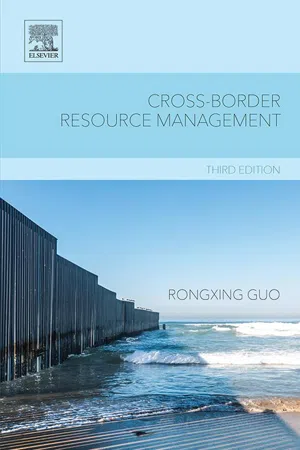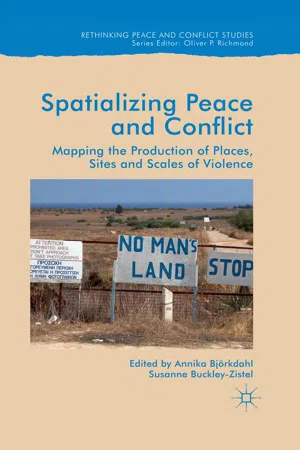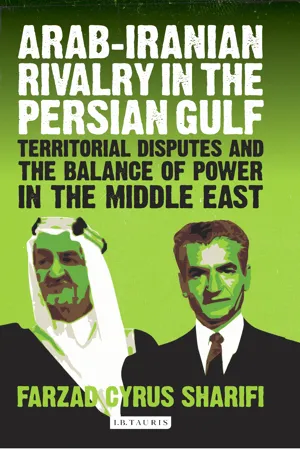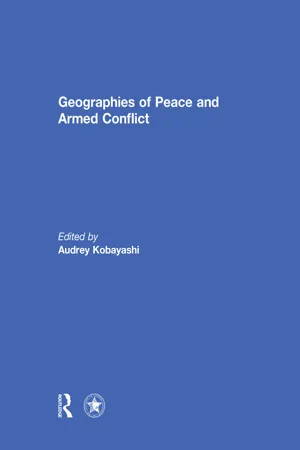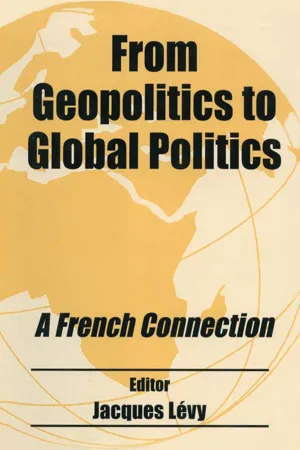Geography
Tensions within Nations
Tensions within nations refer to internal conflicts, disagreements, or divisions that arise within a country. These tensions can stem from various factors such as political, social, economic, or cultural differences among different groups within the nation. They can impact the stability and cohesion of a country and may lead to unrest, protests, or even civil strife.
Written by Perlego with AI-assistance
Related key terms
Related key terms
1 of 4
Related key terms
1 of 3
8 Key excerpts on "Tensions within Nations"
- eBook - ePub
- Rongxing Guo(Author)
- 2017(Publication Date)
- Elsevier(Publisher)
Boundary and territorial disputes often stem from material and/or cultural claims; sometimes they may also emerge as a result of the fundamental changes in domestic and international environments. In certain circumstances, boundary and territorial disputes may even evolve into geopolitical games of big-power rivalry and competition. In this chapter, using 10 case studies, we have analyzed the five factors (resource scarcity, locational feature, domestic politics, geopolitical competition and cultural difference) as well as how they have decisively influenced cross-border tensions in disputed territories.Sometimes, it is very difficult to clarify the real causes behind a specific case of territorial dispute. In most (if not all) circumstances, at least two of the five factors analyzed in this chapter can be simultaneously found to activate an individual case of cross-border conflict or war. For example, geopolitical competition is not the only factor resulting in the brief border war between China and India in 1962. Neither is it the only one impeding the current Sino-Japanese cooperation on the East China Sea. Japan has a tradition of uncompromised territorial negotiations with its neighbours (Examples in this regard can be found in Japan’s fruitless negotiation with Russia on the Northern Territories/South Kurils – see, e.g., deVillafranca, 1993 and Kimura, 2008 ). Also, China’s position on the disputes over the East China Sea has become increasingly tougher since the 1990s (see, e.g., Drifte, 2008 ). With regard to the on-going negotiations on oil/gas exploitation in the East China Sea, locational and domestic factors also are responsible to the current difficulties. Tactically, without cooperation with Japan, China still can unilaterally exploit the hydrocarbon deposits on its (i.e., the western) part of the East China Sea – though the exploitation cannot be economically maximized. But this is not the case for Japan – all of Japan’s claims of the seabed resources have been located at the disputed area.Table 11.1 - eBook - ePub
Spatialising Peace and Conflict
Mapping the Production of Places, Sites and Scales of Violence
- Annika Bjorkdahl, Susanne Buckley-Zistel, Annika Bjorkdahl, Susanne Buckley-Zistel(Authors)
- 2016(Publication Date)
- Palgrave Macmillan(Publisher)
As early as the 1970s, research on international war conceptualized geographic conditions (e.g. direct neighbourhood and spatial distance) as explanatory factors for the occurrence of armed conflict and war (see Diehl 1991; Starr 1991). Ever since, physical features such as borders or contiguity have been identified as enabling interaction between territorial entities, or as providing opportunity structures under which actors formulate preferences and make decisions (Siverson and Starr 1991). Quantitative studies on the causes of interstate wars emphasize the importance of territorial aspects (notably boundary disputes) as the most conflicting among all contentious issues (Vasquez 2009). Here, both the understanding of geography and the twin concept of opportunity and willingness (Most and Starr 1980) are oriented towards the relatively static notion of boundaries as central to methodological nationalism.At present, most quantitative empirical studies of the field operate in a territorial container, though, when focusing on correlations between physical variables such as topography, infrastructure, borders or proximity and conflict. In other words, most studies are based on an understanding of geography that restricts space to allegedly fixed material factors, such as the availability of resources or physical demarcation (bordering) in order to explain and predict armed conflict. One central argument holds that the dynamics of armed conflict are conditioned by the location of and distance to political, natural or other resources – for instance, when arguing that in strong regimes, civil wars are located further away from the capital (Buhaug 2010), or that conflicts last longer if they are located along remote international borders, in regions with valuable minerals or at a distance from the main government (Buhaug et al. 2009).Other studies show that the existence, concentration and type of natural resources impacts on the occurrence of civil war. In this reading, diamonds and oil have highly significant effects, while agricultural goods are hardly significant at all (Fearon 2005; Lujala et al. 2005; Ross 2004). Moreover, centralized resources, such as petroleum or easily accessible mines, are considerably easier to monitor and protect than geographically dispersed resources, such as opium plantations, alluvial diamonds or tropical forests (Le Billon 2001). One critical aspect is also the proximity of key resources to a fighting faction’s headquarters or the capital. Buhaug and Rød (2006) demonstrate furthermore that armed conflict correlates with the spatial distribution of features such as relative road density, while O’Loughlin et al. (2011) found evidence that the proximity to strategic locations (military installations, administrative institutions) affects the incidences and diffusion patterns of violence over time. - eBook - ePub
Arab-Iranian Rivalry in the Persian Gulf
Territorial Disputes and the Balance of Power in the Middle East
- Farzad Sharifi-Yazdi(Author)
- 2015(Publication Date)
- I.B. Tauris(Publisher)
CHAPTER 2 EXPLAINING DISPUTES OVER TERRITORYThis chapter develops an argument about the considerations that are expected to be of principle relevance in explaining the conduct and politicization of Arab-Iranian territorial disputes in the Persian Gulf, particularly in the context of the timeframe in question. In constructing this argument, reference is made to the political geography and international relations literature and the claims that writers have often made about the interests of states in territory and what drives the initiation, escalation and politicization of territorial disputes. In the first section, the more common and recurrent and inextricably linked themes of power, hegemony, natural resources and the strategic dimensions of territory are examined and their possible applications to the disputes and timeframe in question discussed. The second part of the chapter moves on to exploring the emotive and symbolic dimensions of territory and the associated domestic political uses of territorial disputes. The final two sections of the chapter examine the often underplayed and regionally sensitized themes of prestige and rivalry outlined in the previous chapter.It is important to note that all of the factors that are considered in this chapter are inherently interwoven and conditioned by a host of nuanced domestic, regional and international considerations. However, for the benefit of analysis, they are untangled and in large part examined in isolation. The intricate interconnections and linkages between these factors should nonetheless become progressively self evident as the narrative and discussion progresses. Ultimately, the argument that is crystallized is that prestige and regional rivalries, rooted firmly in regional power dynamics, the emotive and symbolic qualities of territory and domestic political considerations, may have been the most pervasive factors in explaining the conduct and politicization of the Bahrain, Shatt al Arab and Abu Musa and Tunbs disputes between the late 1950s and late 1960s. This is an assertion that subsequent chapters will attempt to illustrate. - eBook - ePub
- Geoffrey Sloan(Author)
- 2017(Publication Date)
- Routledge(Publisher)
143The relationships between these three fields do not emerge without paradox. Geo-strategic thinking and action, which emerges out of the juxtaposition of the constraints of geography with the manoeuvres of enemies, are conditioned also by cultural expectations and technological changes, neither of which are static and each of which change according to different temporal dynamics. Geography does not directly condition strategy; instead, it is refracted through prisms of culture and technology. With respect to the geography of state-formation, the most important paradoxical development of the past century is the rise of transnational ethnic groups and the international flow of commodities, finance and migrants – globalization. Even as the state became the unambiguous sovereign over its domain, ethnic minorities and economic developments, each with their own geographies, called the state’s dominance in international relations into question.The next chapter will examine the method and theories of geopolitics. Methodological discussions seek to raise the question, ‘how to?’ How does geopolitics answer the issues raised by theories that juxtapose geography, strategy and history in international relations? This question is important for two reasons. Geopolitical methods point toward the description of the constellation of forces which exist or existed at a particular time and within a particular geographical context. Geopolitical theories may suggest contemporary and even future significance of the various forces as they play out across specific locations and contexts; they juxtapose the enduring with the ephemeral thereby providing a way of explaining past change and predicting future developments.144 An important caveat is that any theory has its limitations: ‘Although theory is never complete and is always bound to be at least somewhat wrong, it performs several very useful functions when it defines, categorizes, explains, connects and anticipates.’145 - eBook - ePub
- Audrey Kobayashi(Author)
- 2013(Publication Date)
- Routledge(Publisher)
The geography of conflict is an expression and a medium for the myriad power relations that cause and facilitate violence. With a focus on interstate violent conflict, we explore the interaction of geographic and network spaces to understand how war spreads through the exercise of a variety of power relations. Traditional conflict analysis, especially in the field of political science, takes a singular view of power and geography, considering them only as fixed attributes in the context of dyadic relations (between a pair of states). Our approach provides a panoramic conception of relational space that uses dyads as a building block to describe the surface across which conflict spreads, as well as to help us understand how states become involved in an ongoing conflict. Furthermore, as an illustrative example, we are able to analyze how the embeddedness or situation of particular power relations shapes the construction of broader social networks to define the multidimensional and multiactor contexts that facilitated the diffusion of World War I.The purposes of this conceptualization and application are founded on developments within the discipline of geography and also the potential and difficulties of enhancing interdisciplinary conversations between geography and the international relations (IR) discipline. As new theoretical understandings of power have taken root in geography and other social sciences, the study of interstate conflict has lagged behind (Allen 2003; Bosco 2006a); however, little of this language or ontology has pollinated the work of geographers analyzing conflict in a systematic manner. Hence, the application of relational power to conflict has been restricted to case studies in geography that are not framed within the normal science projects typical of IR.Simultaneously, the field of IR has renewed its interest in “geography” but has not developed a sophisticated understanding of the term. Instead, physical distance, contiguity, absolute location, and simplified incorporations of terrain predominate (O’Loughlin 2000). The limitations on the understanding of geography are a function of predominant ontologies and the associated understanding of power. The state is the sole actor in the hegemonic data sets used by IR scholars, and conflict is viewed in dyadic terms; various static relationships between two states in a given year (known as the dyad-year) are the focus of analyses. - eBook - ePub
The Relevance of Regions in a Globalized World
Bridging the Social Sciences-Humanities Gap
- Galia Press-Barnathan, Ruth Fine, Arie M. Kacowicz(Authors)
- 2018(Publication Date)
- Routledge(Publisher)
This balance has two dimensions: the level of state capacity in the region and the extent of national congruence between the existing states’ international boundaries and the key national aspirations in the region. The greater the state-to-nation balance in the region, that is, the greater the state capacity and the higher the congruence between boundaries and national identities in the region, the more peaceful will be the region. In contrast, the greater the state failure and the lower the congruence between state boundaries and national identities in the region, the more war-prone the region is likely to be. The state-to-nation imbalance is an underlying cause of regional wars. It makes certain regions more prone to wars than others due both to the emergence of substantive issues of conflict, such as territories and boundaries, and to the enhancement of the security dilemma and power rivalries in the region, under the conditions of state-to-nation imbalance. These power and security factors highlighted by the Realist school are the proximate causes of specific regional wars (see Lebow 1981; Vasquez 1993, 293–97; Van Evera 1995) - eBook - ePub
On Geopolitics
Space, Place, and International Relations
- Harvey Starr(Author)
- 2015(Publication Date)
- Routledge(Publisher)
Given the variety of factors that give territory value, it is not surprising that territory serves as the origin of conflict. It does so through territorial claims (Hensel 2001), territorial changes (Kacowicz 1994), territorial disputes and their settlement (Huth 1996; Huth and Allee 2002; Sample 2002), and strategic concerns, among others. Paul Huth (1996) has used territorial disputes to demonstrate how domestic factors interact with such disputes and to modify realist geopolitical theories. An interesting twist on the strategic importance of territory is found in John Vanzo (1999), who is concerned with the configuration of borders, especially the notion of the “compactness” of states. Similarly, Elliott Green (2012) has investigated the size and shape of African states and concludes that they are not the “arbitrary” colonial artifacts many observers assume. Thomas Christin and Simon Hug (2012) have looked at the interaction of the structure of federalist states, the location of different identity groups, and internal conflict.Many students of international relations have presented arguments for, and reviews of, empirical findings regarding territory/geography as a source of conflict (e.g., Holsti 1991; Vasquez 1993; Hensel 2000; and Huth 1996). One illustrative empirical study by Vasquez and Senese (2003) indicates that territorial claims increase the probability that a pair of states will engage in a militarized dispute (MID) and that such territorial MIDs, in turn, increase the probability of war. A review of the continuously updated set of contemporary armed conflicts by Peter Wallensteen and his colleagues for the Uppsala University UCDP/PRIO data set also reveals the extent to which territorial issues continue to underlie international conflict in the post–Cold War era. For example, 151 of the 248 “armed conflicts” identified between 1946 and 2011 (or 61 percent) involved territory as the “incompatibility” in the conflict (see the data sets listed at www.pcr.uu.se/research/ucdp/datasets/ucdp_prio_armed_conflict_dataset/). Clearly territory (or geography) as a source of conflict falls under both opportunity and willingness.Territory that connects, sits between, or is disputed by two states provides something to fight over. This is not simply a facilitating condition. Territory exists as a possible issue for conflict; it is available as a source of conflict or contention. Because of territory’s value, however—both tangible and intangible—territory is something that people care about and are willing to fight over and is directly connected to willingness. People, groups, and states come into conflict every day during the course of normal social transactions and interactions: Incompatibilities occur, representing incompatible claims of interests and preferences. Most such incompatibilities are managed simply through routine mechanisms or are ignored because they do not make claims to things that are highly valued. The research on territory and conflict indicates that territory is literally always of high value, salience, or importance to people and groups. Territory raises the stakes/value of conflict, thus raising the probability of escalation and lowering the probability of easy management. This is also demonstrated by looking at conflict management from the opposite perspective. Recent research (Gibler and Tir 2010) has shown that when countries do settle - eBook - ePub
From Geopolitics to Global Politics
A French Connection
- Jacques Lévy(Author)
- 2014(Publication Date)
- Routledge(Publisher)
Of course, what counts in past or future decisions is not so much the ‘objective’ reality of territorial changes as a synchronous complex which brings into play the balance of power between A and C, the influence of the major allies (which will be sought precisely for its effect on this balance of power and who, depending on their interests, affinities or historical ties will, or not, hasten to respond), but also the internal influence of ethnic group A in State A (that is to say the relations between A/A/A). Let us think here of Aristotle, who wanted to exclude the owners of land on the fringes of the city from debates on relations with neighbouring cities.Nothing is in itself ‘determined’ in advance, but ‘if … and … if … then …’ the danger (of a conflict or paralysis of State A or a policy favouring expenditure relating to ‘defence’ rather than ‘development’) is greater.To complete the picture of what are clearly very poor relations between these two states (whose representatives can nevertheless meet on neutral ground, specifically State D, which, for a number of reasons linked to greater internal cohesion or the influence of a leader, is ‘non-aligned’), it happens that the configurations of one of the segments ‘offer’ a theoretical advantage to A.A GEOPOLITICAL MODELWith its capital positioned not far from the border, State C can put forward as an excuse the potential ‘threat’ coming from this region of A. It can thus decide to consider the line of hills ‘opposite’ as a potential border in strategic terms since the other party in this particular case has friendly territory at its disposal. Here again, this is the result of voluntary decisions and not of ‘data’ which were written down in advance. But in a general climate of tension, it is more likely that conflicts will occur here than elsewhere. In the meantime, the regional dissymmetry of forces can be used to commit to programmes of military equipment, which can favour one particular power group, and to cement alliances with Empire C. Obviously, the help given to A by C belongs in the broader context which has just been described.It is no longer a matter here of border disputes but of genuine (internal/external) political problems which may involve lasting tensions, so intractable do positions seem. Obviously, the nature of the relations between the two empires has some bearing, but is it decisive? If a ‘painful’ interaction can be explained, how do we account for situations where the relations between two states are peaceful?
Index pages curate the most relevant extracts from our library of academic textbooks. They’ve been created using an in-house natural language model (NLM), each adding context and meaning to key research topics.
Explore more topic indexes
Explore more topic indexes
1 of 6
Explore more topic indexes
1 of 4
